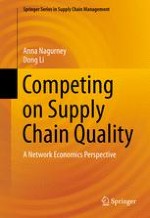2016 | OriginalPaper | Buchkapitel
9. The General Multitiered Supply Chain Network Model with Performance Indicators
verfasst von : Anna Nagurney, Dong Li
Erschienen in: Competing on Supply Chain Quality
Aktivieren Sie unsere intelligente Suche, um passende Fachinhalte oder Patente zu finden.
Wählen Sie Textabschnitte aus um mit Künstlicher Intelligenz passenden Patente zu finden. powered by
Markieren Sie Textabschnitte, um KI-gestützt weitere passende Inhalte zu finden. powered by
